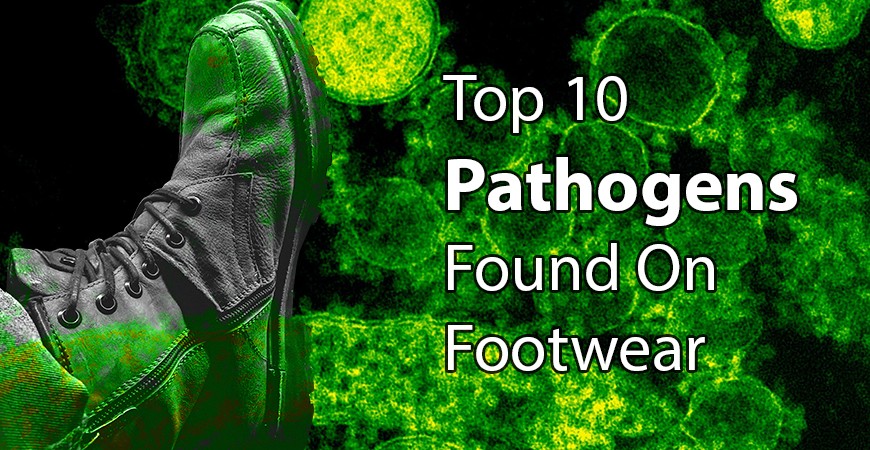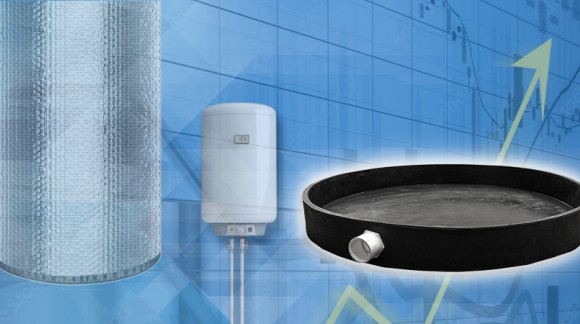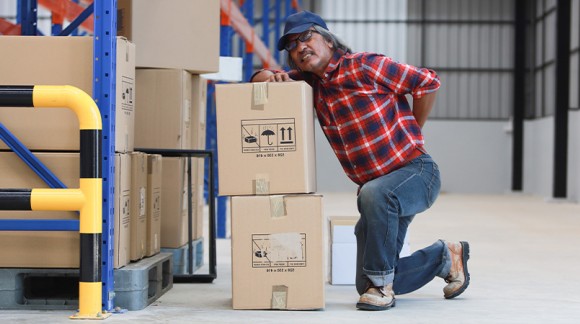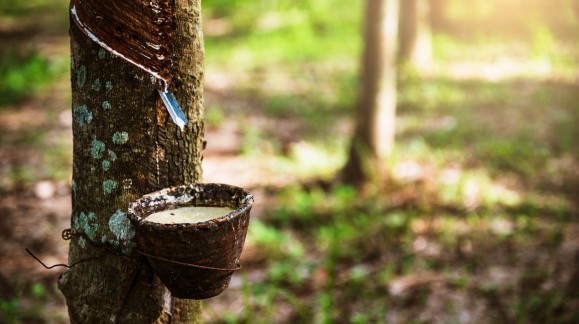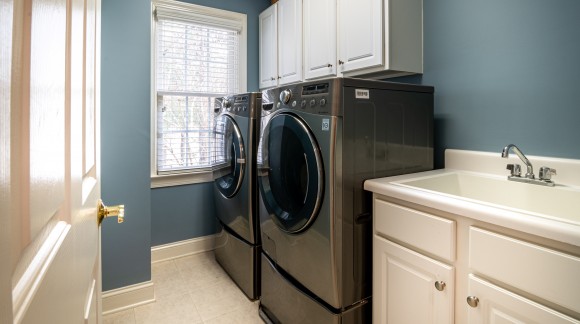Top 10 Pathogens Found on Footwear
Top 10 Pathogens Found on Footwear
As the world makes its way out of a global pandemic, the general public’s focus on proper cleaning, disinfecting, and sanitizing practices will diminish to a degree.
It’s not possible, nor would it be healthy, to eliminate all viruses and bacteria from our homes and common areas. However, there are certain items that can be particularly troublesome when it comes to carrying harmful pathogens, and they should be paid attention to.
Footwear can be one of the biggest culprits of migrating germs, yet many don’t give a second thought to what they may be carrying on their shoes.
Several major studies have been performed on the presence of microbes on footwear, most notably by The Society for Applied Microbiology and The University of Arizona. Both studies came back with findings that footwear is often covered in copious amounts of bacteria, and sometimes viral particles as well.
In short, your shoes are dirtier than a toilet seat.
To help you understand what these germs are and how to defend against them, we’ve compiled a list of the ten most common variations. Please note that they are listed in no particular order, and there are hundreds or thousands of other microbes that could be present on footwear.
Viruses and Bacteria Most Frequently Found on Footwear
- Escherichia Coli (E. coli) - not only can your footwear become contaminated with E. coli after visiting a public restroom, a 2009 study determined that after a walk through town, 70% of pre-sterilized boots tested positive for the bacteria.
- Klebsiella Pneumoniae - this strain of bacteria occurs naturally in soil, so it is commonly found on the soles of shoes. If aspirated, dangerous respiratory infections can occur, so it’s important to disinfect shoes that have been contaminated.
- Serratia marcescens - many hospital-acquired infections are caused by this bacterial strain. Bleach-based disinfectants are effective at eliminating this bacteria, but complete eradication can be a challenge.
- Staphylococcus aureus (MRSA) - this antibiotic-resistant strain of bacteria is common in medical facilities and fitness centers. Gyms and martial arts facilities should take special precautions to protect their patrons from the spread of MRSA.
- Clostridium difficile (c-diff) - inflammation of the colon and other digestive tract issues can occur from exposure to c-diff. A study from 2014 shows that a significant percentage of shoes tested in household environments contained this bacteria.
- Gram-negative bacteria (GNB) - because of their resistance to antibiotics, GNB strains pose a high health risk. Surface disinfection is particularly important with these strains since infections can be so difficult to treat.
- Listeria monocytogenes - a potentially deadly condition, Listeria, can occur when food is infected with this strain of bacteria. From agricultural facilities, food processing plants, restaurants, and everything in between, sanitizing surfaces that could contaminate food is crucial.
- Betaarterivirus suid 1 - this viral strain causes the disease formerly referred to as Porcine reproductive and respiratory syndrome virus (PRRSV). Pig farms and pork processing facilities must take every precaution necessary to avoid this microbe from being passed on to consumers. A 2004 study concluded that “bleach containing boot baths were efficient to prevent mechanical transmission of porcine reproductive and respiratory syndrome virus (PRRSV)”.
- Campylobacter jejuni - campylobacteriosis bacteria often occurs when raw or undercooked poultry is consumed or cross-contamination occurs in other food. According to the CDC, over 1 million people are infected each year.
- Salmonella - infections by salmonella bacteria occur when it enters food and water supplies, and it’s responsible for the majority of food poisoning cases around the world. A study in 2004 found that salmonella bacteria was even found on footwear after walks in the park and other common areas.
It looks like Mom was really onto something when she yelled at us for having our shoes on in the house...
How to Clean and Disinfect Your Shoes
Don’t live in fear of these germs. Rather, take simple measures and precautions to clean, disinfect, and sanitize footwear.
Depending on the environment, your needs for footwear sanitization may vary. Some of the heavier use applications will require hosing down and cleaning footwear before disinfecting and sanitizing.
Some of the most common applications include:
- Hospitals, laboratories, and surgery centers
- Wrestling, cheerleading, gymnastics, martial arts, and other fitness facilities
- Agricultural and food processing plants
- Petroleum refineries and chemical handling facilities
- Automotive, raw material, industrial, and other manufacturing centers
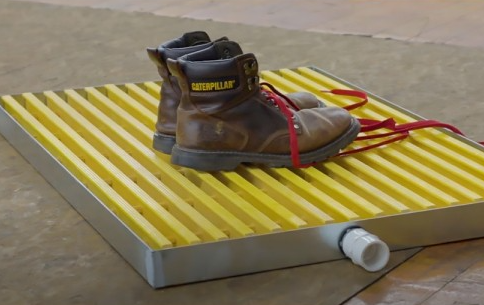 In situations where cleaning of footwear is required, we recommend the use of a boot wash station. This spill containment platform consists of a galvanized steel drain pan with FRP grating inlays. Installed with a drain line, you can easily wash away dirt, debris, and contaminants for boots and other footwear.
In situations where cleaning of footwear is required, we recommend the use of a boot wash station. This spill containment platform consists of a galvanized steel drain pan with FRP grating inlays. Installed with a drain line, you can easily wash away dirt, debris, and contaminants for boots and other footwear.
Many of our industrial clients opt for a more permanent solution. In these applications, we'll custom manufacture a boot wash station that's the exact dimensions you need, and can even add features like floor mounting tabs.
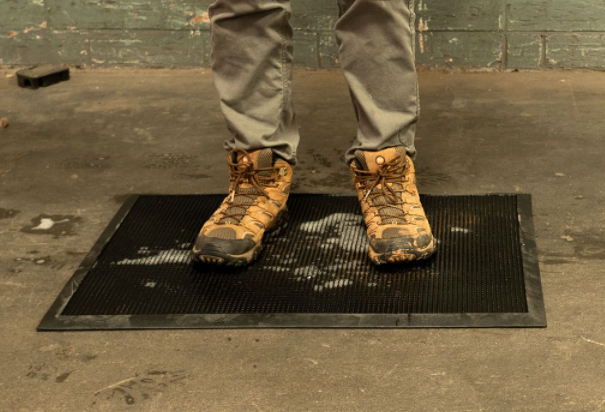 When it comes to sanitizing and disinfecting your footwear, a sanitizing floor mat is the best tool for the job. These rubber mats can hold various liquids like bleach solutions and other chemicals designed to kill harmful pathogens. After filling the mat with liquid, wipe the soles of your shoes on the scrubbers. Finally, dry the shoes off with an absorbent pad or towel, and you’ll be clear to enter the sanitary environment.
When it comes to sanitizing and disinfecting your footwear, a sanitizing floor mat is the best tool for the job. These rubber mats can hold various liquids like bleach solutions and other chemicals designed to kill harmful pathogens. After filling the mat with liquid, wipe the soles of your shoes on the scrubbers. Finally, dry the shoes off with an absorbent pad or towel, and you’ll be clear to enter the sanitary environment.
The sanitizing floor mats are available in two sizes (24" and 30"), and are made of a durable natural rubber material. In combination with the boot wash platform, you'll have a convenient and long-lasting footwear cleaning station.
As always, Killarney Metals is here to help with any custom requirements. Shop our 200+ products in stock and made to order, design a custom pan, or contact us for help with unique projects!

